Focus Keyword: How to Choose and Use in Your Content [With Examples]
When it comes to focus keywords, typically, there are two kinds of reactions. You are either in the camp that thinks it’s rocket science (no worries, we got you). Or you are not even sure what the fuss is all about.
After all, it’s just knowing how to pick and match keywords, right? Right?! Umm…no.

It’s a whole lot deeper than that. Imagine you can say only five words to convince someone to date you — only five words. That’s how focus queries work — kind of like speed dating (slightly exaggerated, but you get the point).
So, is it all about picking just one phrase that’s good enough to turn your content into the hottest new thing? Sort of. While it sounds quite complicated, don’t worry!
In this guide, we’ll break down how to find a focus keyphrase that matters without losing your mind.
Contents
What Is a Focus Keyword?
Focus keywords are the main words or phrases that perfectly capture what your page’s topic is all about. You know, those carefully selected queries you want the post to rank for — that’s it (yes, it’s easy on the surface)!
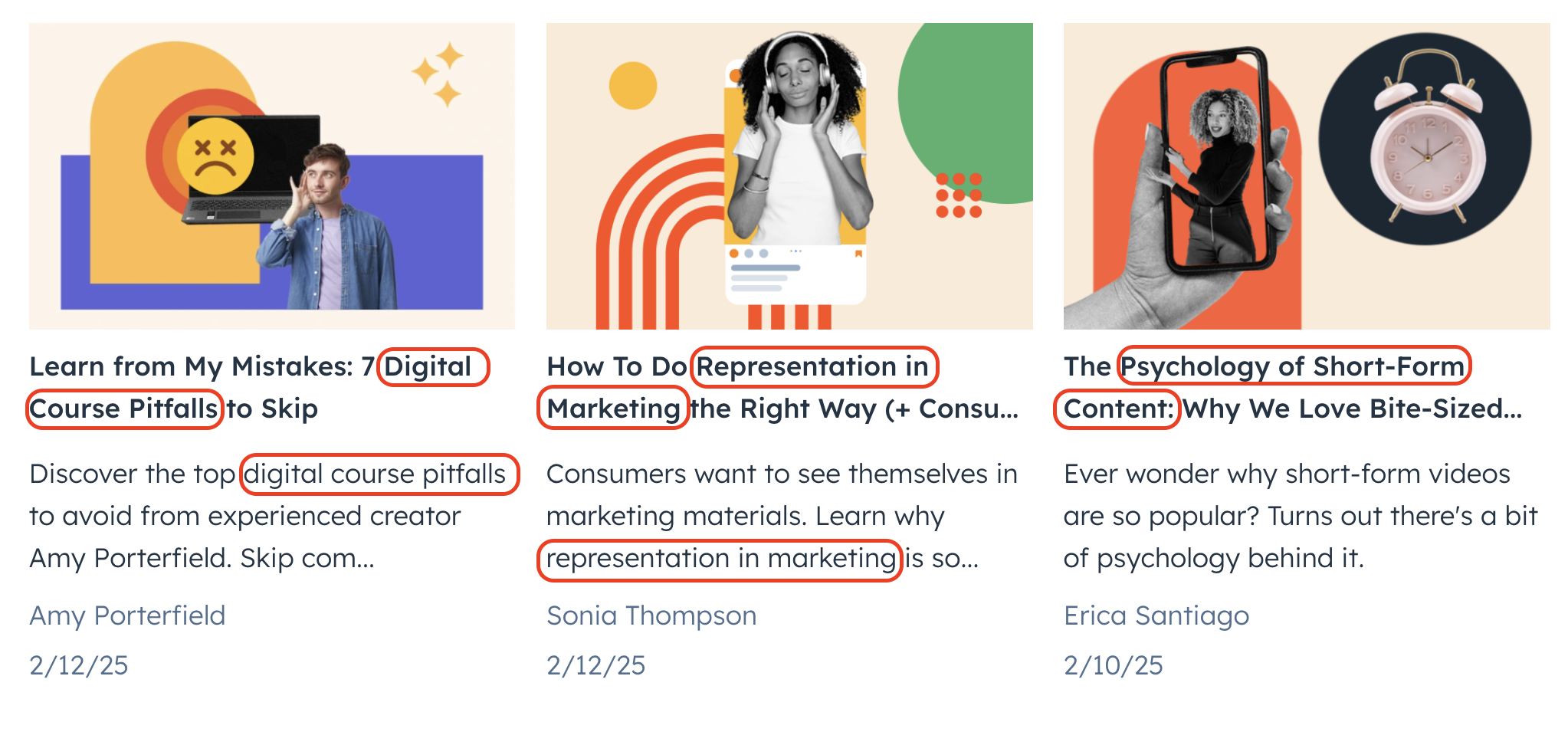
Source: Hubspot
Usually, those are the same words that your target audience is looking for online. If your blog was a map to help guide your readers to something of value, your focus keyword would be the compass, then.
Besides, normally, you would use them for both your own blog and guest posting (even if those are paid links). Why? Simply because if you want your content to rank and get some traffic, it is the only way to go about it.
🤔 Can you guess what the SEO focus keyphrase for this article is? Hint: It’s in the title. And you can repeatedly see different forms of it in the body as well.
Focus Keyphrase Examples
The thing about it, though, is that it’s going to look different for everyone. After all, there are so many niches, and each one has its own needs. Still, let’s take a look at a couple of focus keyphrase examples to show you how this works in real life:
💪 Health and fitness blogs:
Blogs in the fitness industry are different, so their content won’t be the same either. Still, some of the examples you could consider are phrases like “full-body pilates workout,” “healthy meal plans for weight loss,” etc.

Source: Popsugar
🌍 Travel niche:
Based on your target customers in the travel industry, you could use phrases like “X affordable honeymoon destinations” or “best luxury winter escapes.” If you’re aiming at older people, you might use queries like “budget-friendly countries to retire to,” etc.

Source: Private Plan
💸 Finance-related niche:
How about focus keyphrase examples you could use in the economy- and finance-related content? It’s a broad niche, but some of these might be “passive income ideas for retirement,” “best low-risk investments,” etc.

Source: Investopedia
🍝 Food blog:
Most food blogs tailor their posts to appeal to their readers with very specific words. A generic cooking website might use words like “best Italian pasta recipes,” “no-bake desserts,” etc.
For those looking to attract people who follow a particular diet, it may be phrases like “keto dinner recipes ” or “simple vegan protein recipes for runners.”

Source: Delish
🍝 Food blog:
Now, you probably see that when it comes to SEO, you have to be very intentional about which words you use in your content and how you use them. Why is that? The answer to this brings us to the next section.
Why Does It Matter?
It’s relatively easy to craft just any content. You can get some inspiration from your competitors, tell about your day-to-day workflow, or simply share your thoughts. Yet, even if this content is incredibly useful and valuable, it might not work.
Unless you have a clear SEO strategy behind the pieces you post, most likely, you’ll end up buried on the 100th page of SERPs.
This is sad and draining (especially if you’ve spent days or even weeks working on your blog post), but that’s how the algorithm works. After all, it’s no secret that about 96% of content does not get any traffic at all.
Still, using the right SEO focus keyword could prevent this from ever happening in the first place. And that’s just the tip of the iceberg. There are so many other benefits you can get when using focus queries:
- Attract the right people. The internet is a pretty big place, and there are all kinds of users searching around at all times. So, when you’re using focus keyphrases, you’re targeting those who actually want what you are offering.
- Maintain a competitive edge. You’ve probably (read as definitely) got other sites that are also targeting the same market as you do. In some niches, the competition is simply wild.
- Provide the best user experience. Imagine that people keep clicking on your site but never hang around. This most likely means they’re having a terrible experience on your page. Often, this is because what they see doesn’t match what they expect.
- Help search bots understand your site. Yes, Google might also need a hand from you. When you’re using clear focus queries, you’re signaling to search engines, “Hey, this is what my article is all about.”
This is a big deal since you don’t really need people to simply click, look around, and never buy from you. What’s the point of all these SEO tactics, then?
Yet, using the right focus phrases could be the difference between ranking on the first pages of search results or somewhere at the bottom.
Guess what? You can solve this by using proper focus queries. They will simply help you understand what to concentrate on. And as a result, your readers won’t be disappointed.
Google sees that and right away indexes your page and ranks it properly. But it isn’t just for the algorithm. People also tend to get a clearer idea of your topic when you use your focus phrases correctly (more on this later).
TL;DR: Focus keyphrases (keywords) are crucial if you want to get better SEO rankings, attract the right traffic, and stand a better chance than your competitors. If you think about it, it’s crazy that you can get all these benefits thanks to just one little SEO tactic.
Focus Keywords vs. Other Keywords: What’s the Difference?
Now, you can probably give an answer to a question like “What are focus keywords?” But what makes them different from regular keywords? Is this one of those “tomahto-tomayto” situations? Not really. Let’s see what it’s all about.
Any piece you write can have many different keywords — related phrases that affect the visibility of your content. Some of them might be more important and harder to rank for than others. This is where the idea of secondary keywords comes in.
So, in a blog post about “best low-risk investments,” you could have other relevant keywords that would include terms like stocks, bonds, index funds, mutual funds, etc.
More importantly, you’ll have to use synonyms (phrases with similar meanings). In this case, these are “low-risk assets,” “low-risk securities,” “safe assets,” “low-risk investing,” etc.
If we go back to that same article we’ve referenced above, you’ll clearly see what we’re talking about. This blog post is titled: “11 Best Low-Risk Investments: Safest Options for 2025.” In this case, “low-risk investments” is the focus keyword, while other synonyms are secondary.
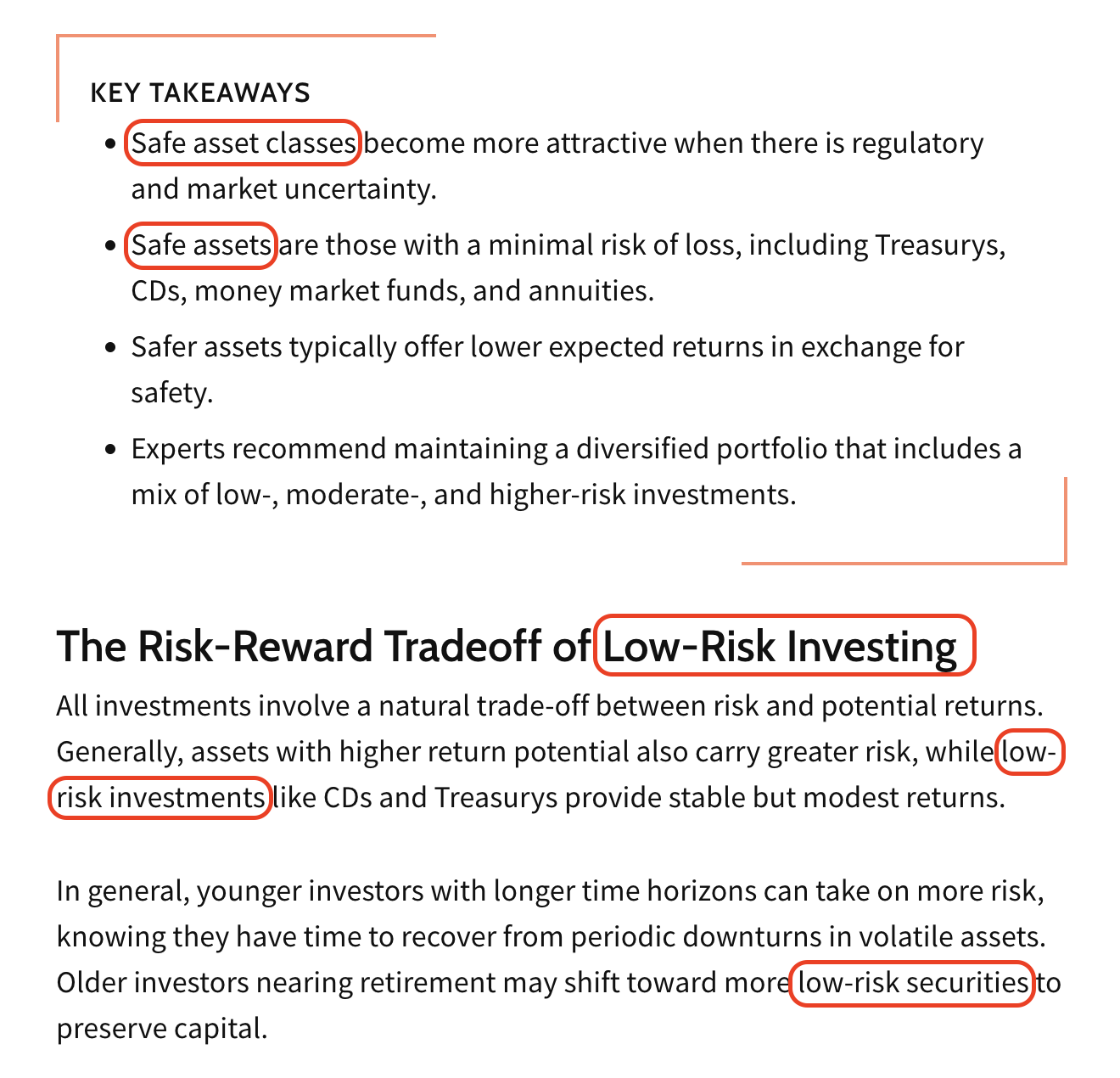
Source: Investopedia
These additional words not only help you paint a clearer picture of what you mean by “low-risk investments.” You also get to talk about different aspects of your topic.
But no matter how comprehensive your content is, there can only be one focus keyword. It’s kind of like the ring in the Lord of the Rings trilogy, ruling the other keywords. Basically, all the additional keywords and the entire content support the main focus query of your article.
How to Find the Most Relevant SEO Focus Keyphrase
Finding these focus phrases is where the real work lies. Say you discover some popular, relevant keywords with a decent difficulty level and a good search volume. Is it enough? No, but it’s a great start!
By the way, if you don’t know how to do keyword research, we’ve shared all the details in this guide.
Anyway, let’s assume you already have a list of decent keywords. Which ones are “focus”? How can you find them out of hundreds of other potentially appropriate phrases?
That’s a great question! And here are our top tips:
1️⃣ Understand Search Intent
Even if a phrase has a ton of searches, that does not mean you should use it in your content. Ha? Yes! You’ll see why it’s like that in just a moment.
You see, before you decide on the keyword you need and start writing, you have to understand what the user really needs when they google this. This is what search intent is all about.
When you know what your website visitors expect to see on each page, writing copy becomes so much easier. These are different types of search intent you have to keep in mind:
- Informational. As the name suggests, this is when a user just wants some information. Basically, it’s when they do their research. This step also matches with the first stage of the sales funnel.
- Navigational. We bet you’ve used your phone many times when looking for a specific place, site, store, etc. It’s the same thing for your audience. Navigational searches mean that a person is looking for a particular brand, page, or place.
- Commercial. This is the so-called consideration stage. Here, people need more details about the product they already want to buy. In this category, you’ll often see comparisons. Your main goal at this point is to show that you’re the best choice.
- Transactional. That’s it! Now, the person is ready to take action. They just want to know how and where they can do it. And if you’re the one who can give those answers, you’ll get a client.
🤔 An example of this kind of search is “How do I become fluent in French?”
🤔 An example could be something like “Alo yoga pants.”
🤔 An example of this one is “Best winter cycling gloves.”
🤔 An example would be “Buy Samsung Flip 6.”
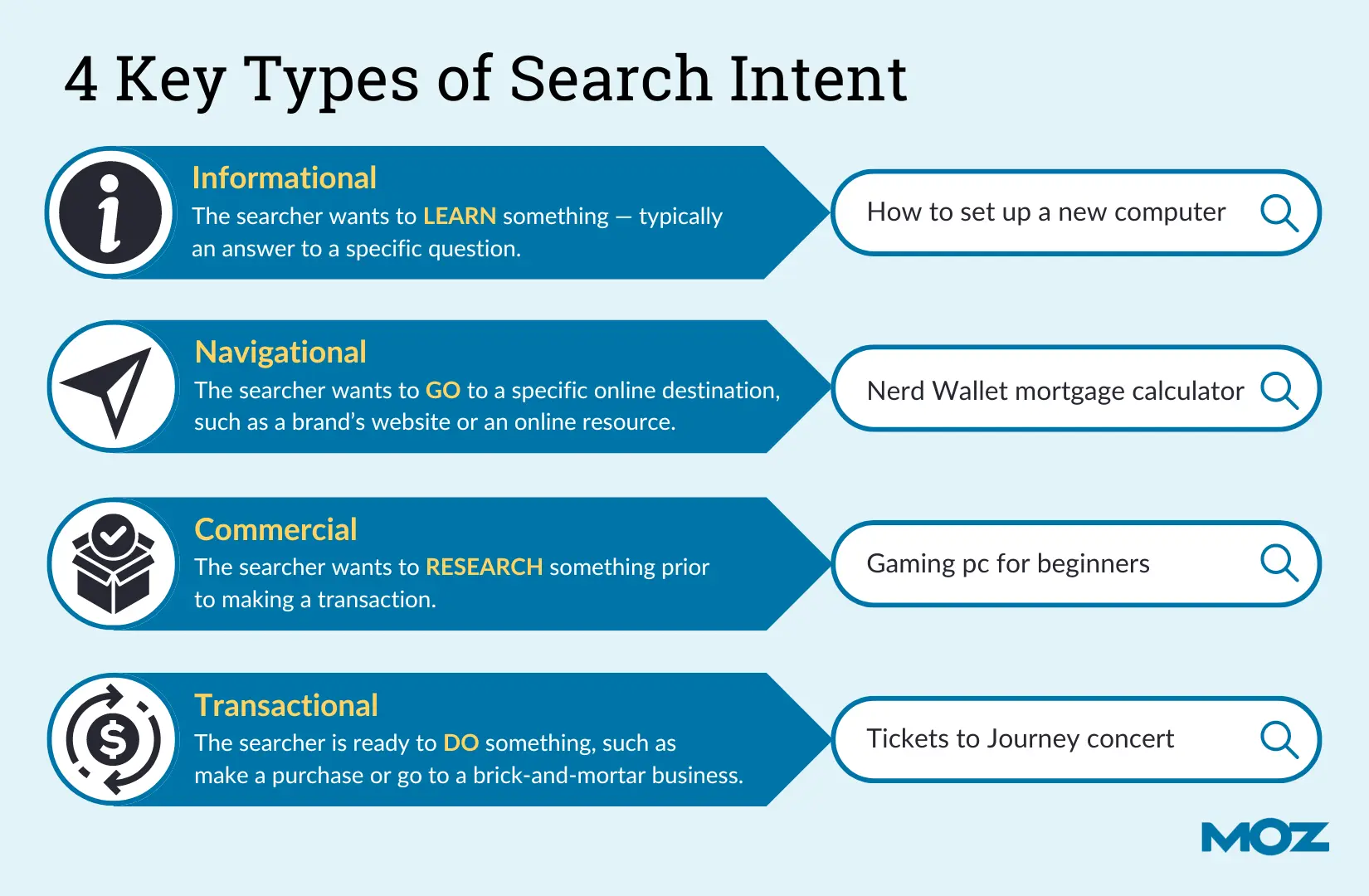
Source: MOZ
Once you understand the different types of intent, it’s pretty easy to spot the best focus keywords for SEO. Simply select the most promising keywords in terms of difficulty and search volume (more on this later) and check whether they match a relevant search intent.
Alternatively, you can find the phrases people are repeatedly using to stumble upon your posts or the posts of your competitors.
Then, notice which pages users start with and go on to interact with. Naturally, it’s better when you use SEO tools for this, as you’ll get more accurate data this way.
Besides, every time you create content, make sure you keep search intent in mind. Say you’re using the keyword “how to make authentic Bolognese sauce” in your article.
In this piece, comparing different Bolognese sauces or telling its history is useless. Readers want to see a straightforward step-by-step guide — a recipe.
And that’s what you have to give them. Don’t try to be overly creative here. If you know that people expect a certain structure, content, etc., just provide that. Easy. =
2️⃣ Do Keyword Research
We touched on keyword research just above, but let’s dig deeper. How else are you supposed to find the golden SEO focus keyphrase? Since keywords really are what help you create helpful content, you need to know the best ways to discover them.
You already have a ton of tools like Google Keyword Planner, Ahrefs, Semrush, etc. All of these are designed to make this process as easy as possible. As we’ve mentioned already, when you find these keywords, you want to compare the keyword difficulty (KD) vs. search volume.
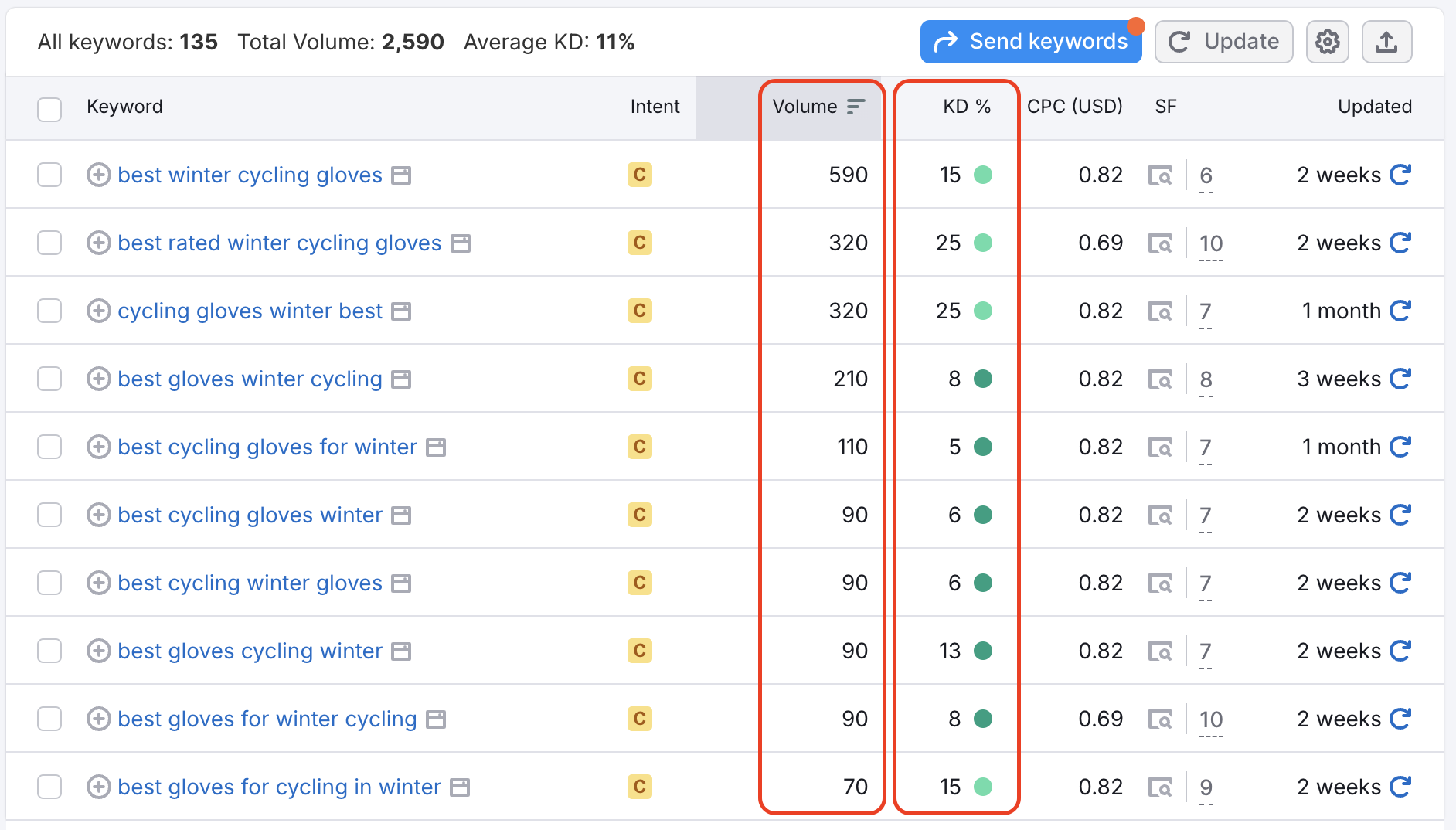
Source: Semrush
The higher the keyword difficulty, the harder it is going to be to rank for that query. Yet, going for the easiest phrases all the time might not be the best idea. If they don’t have enough search volume, you won’t get any traffic.
So, yes, of course, you can choose keywords that have a search volume of 20, 50, and 70. But when it comes to the focus phrases, ideally, they should be getting over 250 monthly searches. All the other low-traffic queries can become your secondary keywords (they’re perfect for this).
It’s also a good idea to see who’s currently dominating the search results for your target phrases. You don’t want to go toe-to-toe with industry giants in your niche. If you’re much smaller, outranking them for the same keywords will be nearly impossible.
Sounds like your case? Then, try to find similar queries that don’t have that fierce competition and optimize your content for those.
3️⃣ Consider Additional Factors
Until now, we’ve mostly focused on keyword difficulty, search volume, and search intent. These might already be enough to choose your focus keyphrase. But of course, if you want to master this tactic, you’ll have to keep other factors in mind as well:
- Remember about short-tail vs. long-tail keywords. Short-tail keywords are phrases made of just a few words (usually not more than three). These are typically broad and talk about general topics, e.g., “vegan meals.”
Long-tail keywords, on the other hand, are longer and more specific. An example would be “high protein post-workout vegan meals.”. Clearly, short-tail queries have more competition since the search volume is higher.
Often, the short-tail keyword will be your focus one, while long-tail phrases will become your secondary keywords. But you can also use a long-tail query as the main one if it makes sense in terms of search volume.
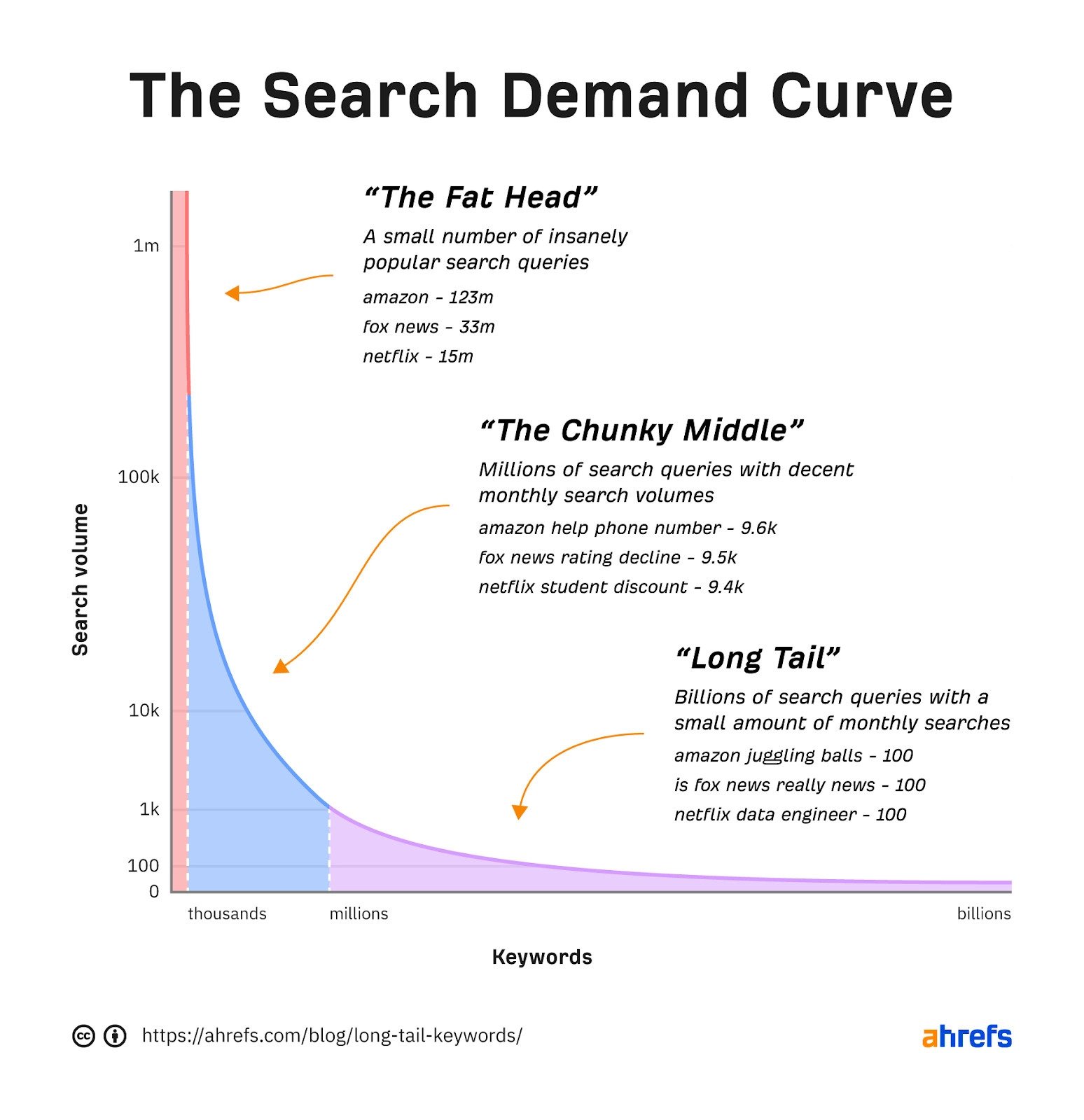
Source: Ahrefs
- Consider user engagement and conversions. When choosing keywords, sometimes, you have to step aside and look at the bigger picture. Will this or that keyword attract your target clients? Will it make them click that CTA button?
- Don’t target overly competitive queries Of course, ranking for a super high-search-volume keyword is a dream of every business. But be realistic. Do you have both the time and resources to beat the giants in your industry?
- Don’t ignore easy-to-rank-for keywords. Keywords with low KD might not have a ton of traffic. But ignoring them isn’t the best option simply because you can rank for them relatively easily.
Sometimes, the query can be perfect according to all the metrics, but it won’t fit your business needs. Yet, of course, it isn’t about the keyword alone. Your content has to be very good as well, especially for conversions.
If that’s not the case yet, prioritize simpler queries first.
We don’t tell you to forget about the “sweetest” keywords in your industry. Of course not! But things take time when it comes to SEO, so be patient and start small.
Best Practices for Using Focus Keywords in Your Content
You might be thinking that SEO is straightforward. When people type your focus keyword into a search engine, your webpage should pop up, right? Yeah, well, it’s not always that simple.
It’s one thing to know how to find the right phrase, but it’s another thing to use it effectively. In reality, it isn’t that complicated. So, you can simply follow these 3 rules, and you’ll be good to go:
#1 Only Use One Focus Keyphrase per Content Piece
With this tip, we don’t want to say that you should only target one keyword per content piece — not at all. You could do that, of course, but it is still best to use multiple related queries in every piece you publish. So, what are we talking about, then?
Here, we’re referring to focus keywords only. Let’s see a real case to simplify the whole thing:
Remember the “best winter cycling gloves” keyword we showed you before? Basically, it could be your focus query. If you were to write a blog about different cycling gloves, you could use additional (secondary) keywords like “best gloves for cycling in winter” and so on.

Source: Semrush
But if we were to mix in another keyword like “best summer cycling gloves,” it would be too much. Why? Even though it’s related, the topic is different, and very few people would search for both winter and summer gloves at the same time.
This is why we talked about search intent at the very beginning. So, “best summer cycling gloves” would work much better as a focus query/topic for a different blog post you write. See the difference?
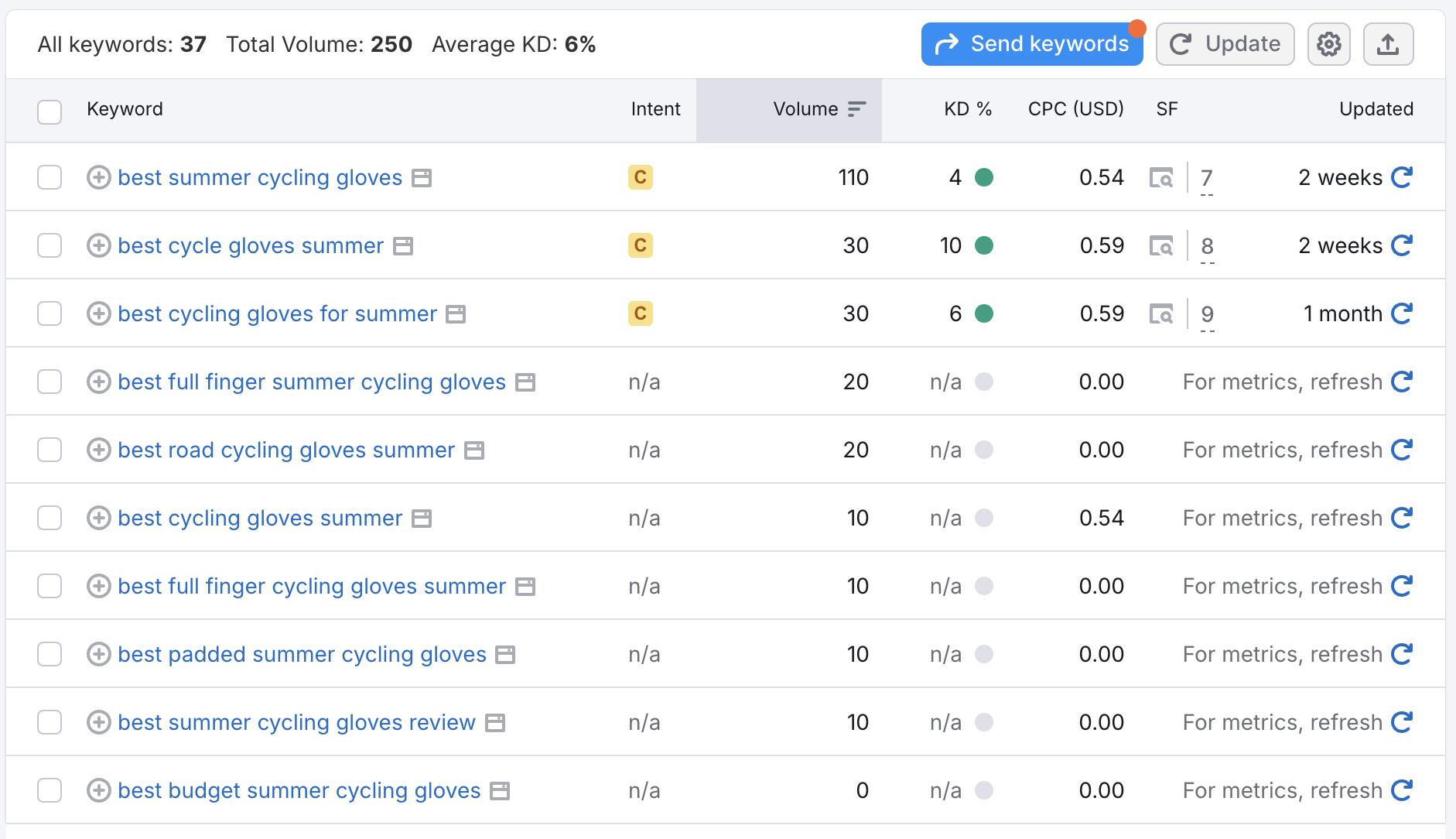
Source: Semrush
Apart from the obvious reasons we’ve mentioned above, having only one focus phrase per content piece also makes your content easier to understand. Besides, this is how you make sure that search engines get the gist so they can rank your page appropriately.
#2 Place Them Strategically
Another important thing is that your focus words should appear in strategic positions on your webpage. This includes places like:
- Title tag and meta description. If your focus phrase is “how to start a YouTube channel,” your title tag could say, “How to start a YouTube channel for absolute beginners.”
Your meta description could then be, “Find out how to start a YouTube channel with zero experience and start earning extra income. We’ve got you covered on everything from gear to marketing.” Here’s a real-life focus keyphrase example of this in practice.

Source: Google
- URL slug. Since a slug is meant to perfectly describe what a web page is about, you want to include your focus phrase here.
What is a focus keyphrase example we could use to show how this works? Here’s a good one: “www.samplesite.com/how-to-start-youtube-channel.” Or you can also take the example from above:

Source: Semrush
- H1 and headings (H2, H3, H4). Apart from the meta title, meta description, and slug, mention your focus query in your title (H1) and other headings.
Of course, this doesn’t mean that you need to add them to every other subheading. Only use it once or twice where it makes sense. You want to make it look natural while improving readability.
Here’s an example from a Backlinko blog post titled “On-Page SEO: The Definitive Guide.” Want to guess what the key phrase is?
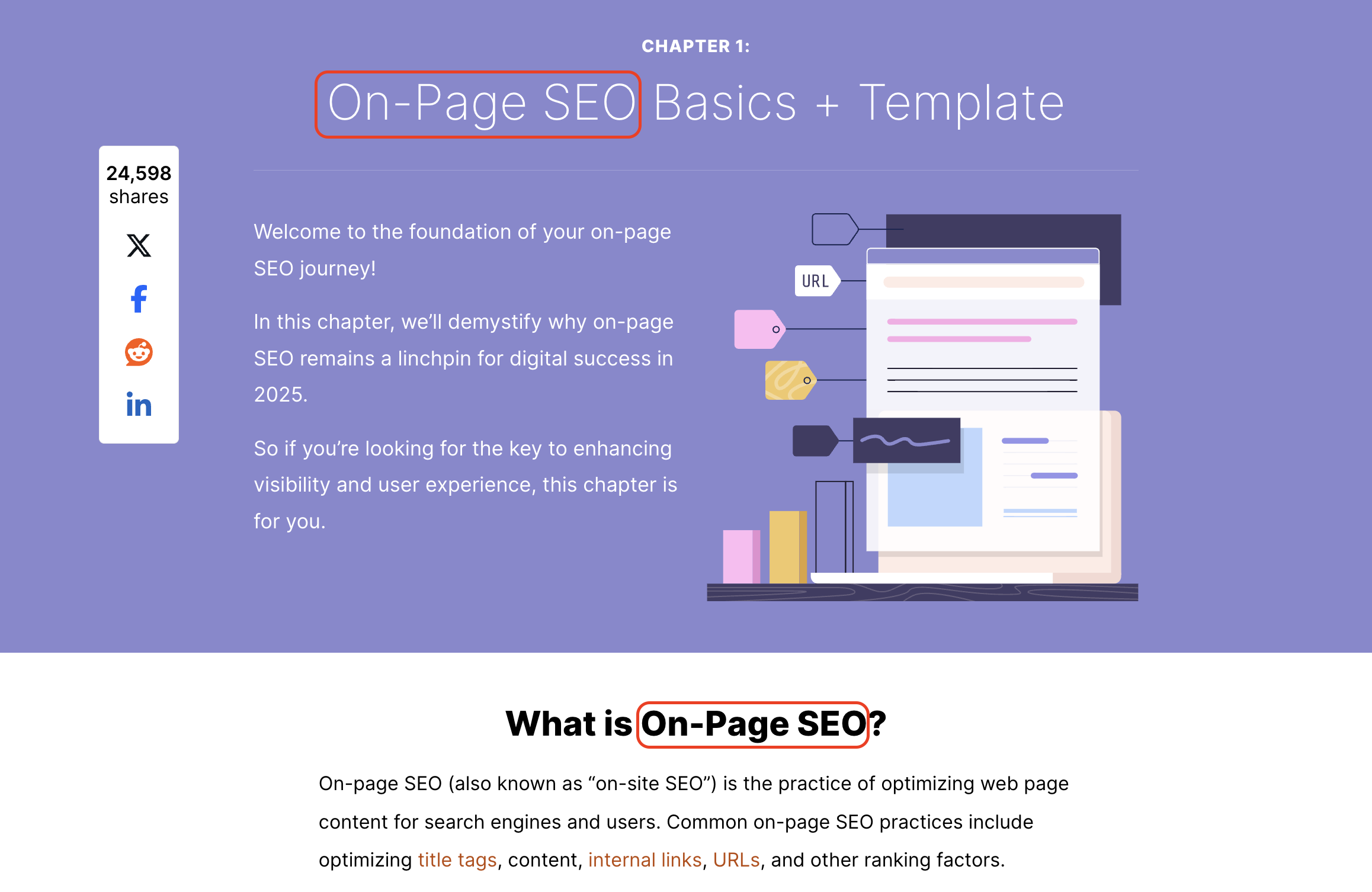
Source: Backlinko
- First 100 words of the content. You want to clue in the search engines as early as possible so they understand what your content is all about. So, using your main keyword naturally in the first 100 words of your post is a good start.
You can also use synonyms for this one, like what we do in the example below:
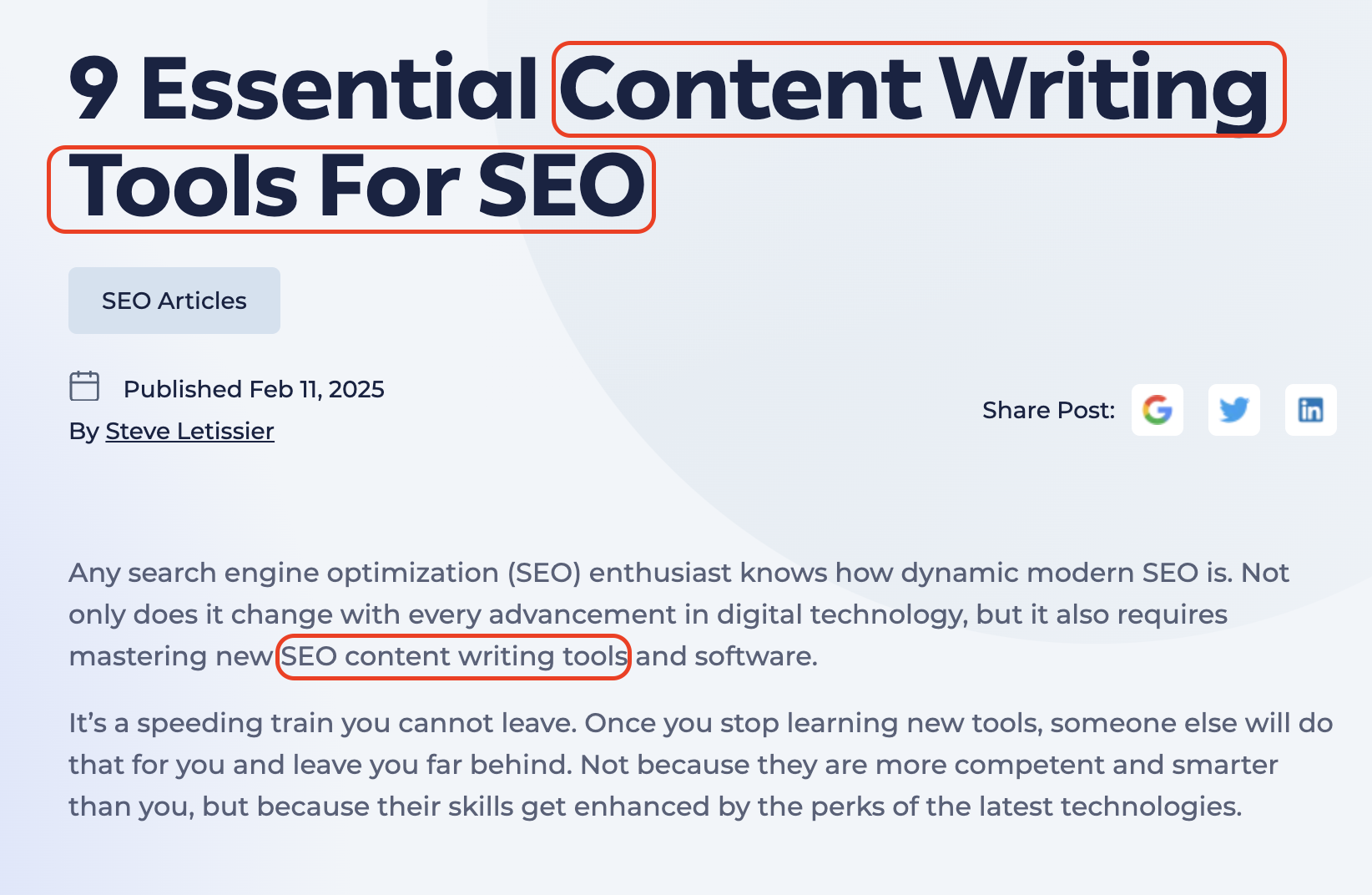
Source: LinksManagement
- Image alt text. Adding your focus words to the alt text can do wonders for your image SEO ranking. So, what should it look like?
For our imaginary YouTube guide, an image of a YouTube channel with lots of traffic can have an alt text that reads “how-to-start-a-youtube-channel-checklist.” Yet, of course, you don’t have to use keywords in alt texts if they don’t fit in naturally.
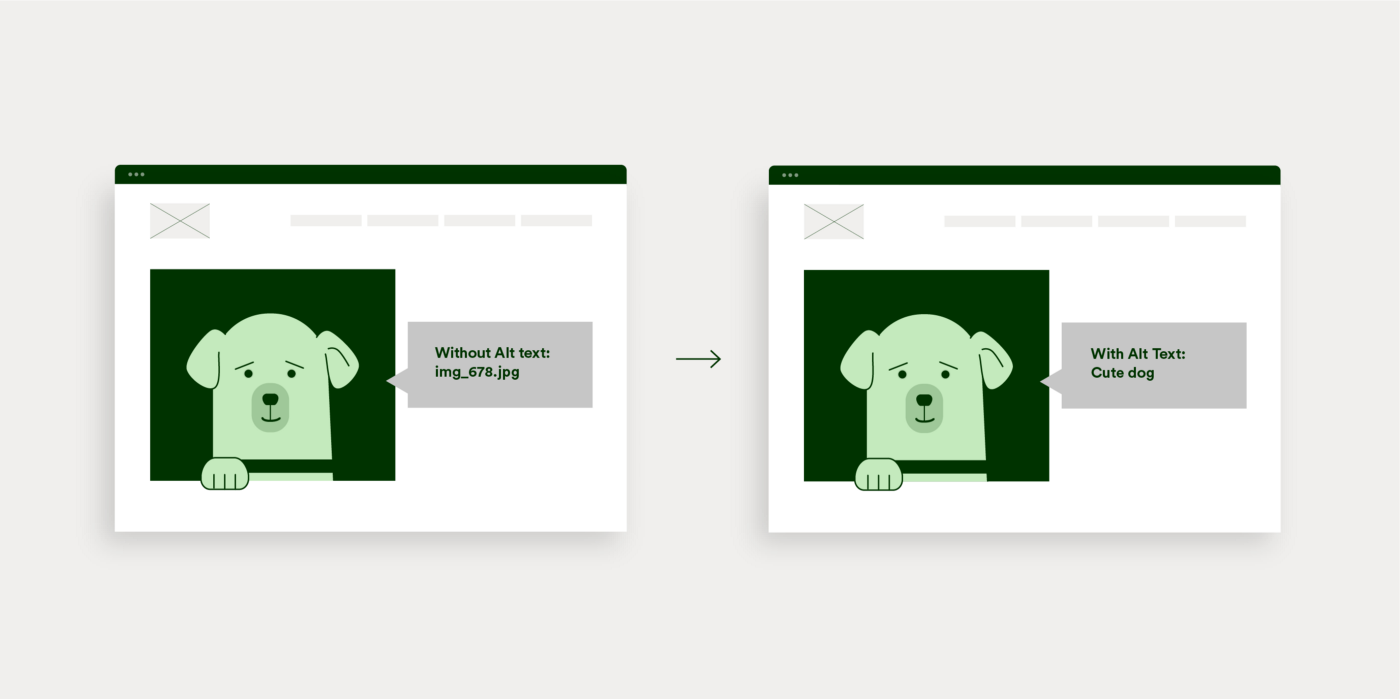
Source: Hex Studio
- Use focus phrases here and there throughout the content (without keyword stuffing). This one is straightforward. Add your focus query in various parts of the body of content. Just be careful not to overdo it, or it can quickly become spammy.
Sounds like too much work? Not really — at least not if you do it again and again. Just ensure that all your keywords (both focus and secondary) fit naturally into the content around them. The idea is to make sure they don’t stick out like a sore thumb.
#3 Never Prioritize Optimization Over Quality
Throughout this whole guide, we’ve talked a lot about optimization. Well, that’s really what the focus phrase is all about. Still, here is the most important tip for any SEO tactic — never sacrifice content quality for optimization.
No matter what practices you’re using, Google will always love and value the quality content first (you know, all that E-E-A-T stuff).
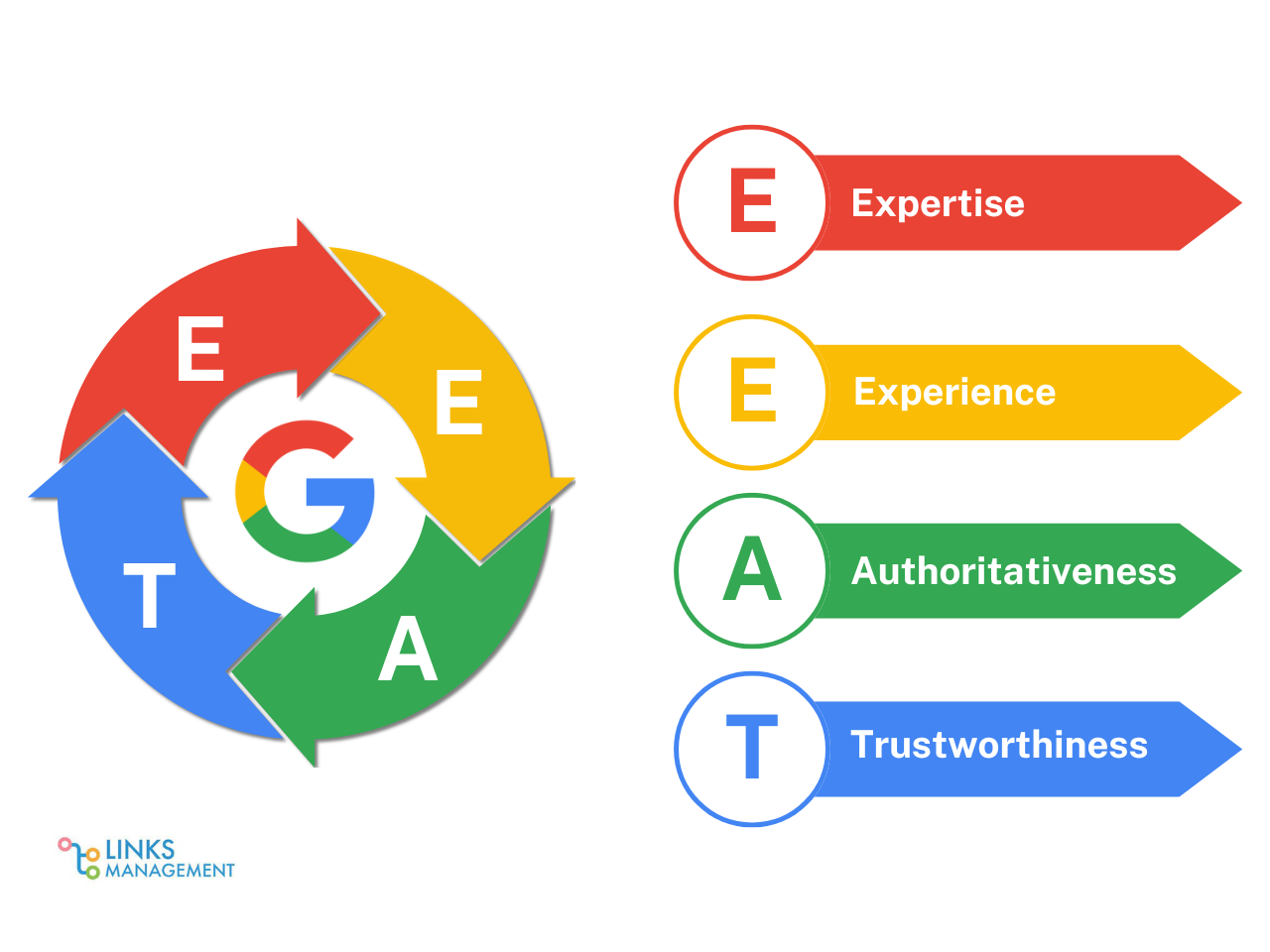
So, make sure you’re not prioritizing optimization practices over the value. How do you pull this off? You can use these tips to optimize your content “naturally”:
- Write as you would normally do. Don’t try too hard when it comes to SEO. If your content flows like you’re talking to a friend and the key phrases just fit in snuggly, you’ve won.
- Use synonyms and related terms to avoid repetition. This one is pretty basic, but you’d be surprised by how many people forget about it.
- Format for better UX. Like in all our focus keywords examples, the way your content is formatted plays a big role. You don’t want to scare anyone away with a huge wall of text. So, use bullet points to highlight your main points and keep your paragraphs short and skimmable.
Does this sound like a challenging task? We’ve got a straightforward guide to website copywriting that can help.
Instead of repeating your key phrases like it’s some kind of spell, you should use their synonyms or other related words that mean the same. So, “best 2025 SEO tips” can simply become “top SEO hacks,” etc.
Conclusion
At this point, you should be confident in your ability to hit your own SEO goals with focus keywords. Are you? If it still feels like a lot of information to process, take your time because it could really be too much.
While you already know many good tips you can use, don’t stop here. Keep learning and improving your skills — not just with keywords but with other aspects of search engine optimization as well.
All that knowledge adds up, and that’s what helps you become a pretty powerful brand in the long run.
Enter URL & See What We Can Do Submit the form to get a detailed report, based on the comprehensive seo analysis.





